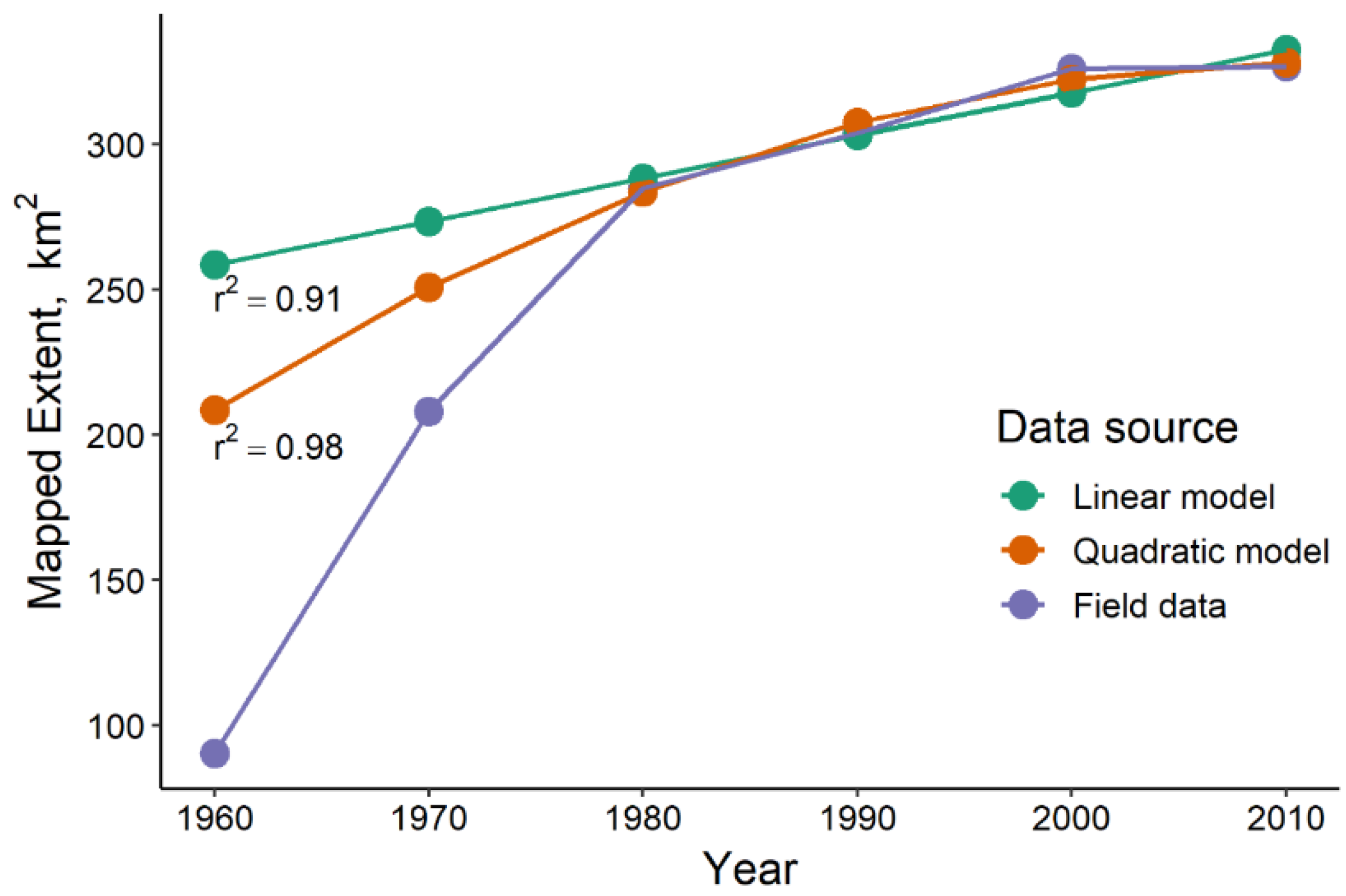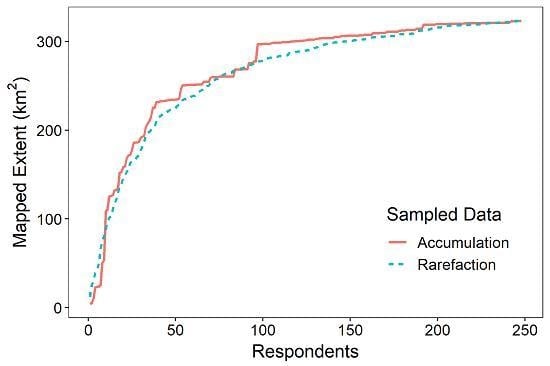How Much is Enough? Improving Participatory Mapping Using Area Rarefaction Curves
Abstract
:1. Introduction
2. Materials and Methods
2.1. Study Site
2.2. Interviews and Participatory Mapping Procedures
2.3. Integration of Maps Depicting Long-Term Fishing Effort
2.4. Rarefaction Curves
3. Results
4. Discussion
4.1. How Much is Enough?
4.2. Creating Robust Participatory Maps
4.3. Essential Role of Maps
5. Conclusions
Author Contributions
Funding
Acknowledgments
Conflicts of Interest
References
- Kroodsma, D.A.; Mayorga, J.; Hochberg, T.; Miller, N.A.; Boerder, K.; Ferretti, F.; Wilson, A.; Bergman, B.; White, T.D.; Block, B.A.; et al. Tracking the global footprint of fisheries. Science 2018, 908, 904–908. [Google Scholar] [CrossRef] [PubMed]
- Richards, D.R.; Tunçer, B.; Tunçer, B. Using image recognition to automate assessment of cultural ecosystem services from social media photographs. Ecosyst. Serv. 2018, 31, 318–325. [Google Scholar] [CrossRef]
- Berkes, F. Sacred Ecology, 3rd ed.; Routledge: New York, NY, USA, 2012; ISBN 978-0415517324. [Google Scholar]
- McMillen, H.L.; Ticktin, T.; Friedlander, A.M.; Jupiter, S.D.; Thaman, R.; Campbell, J.; Veitayaki, J.; Giambelluca, T.; Nihmei, S.; Rupeni, E.; et al. Small islands, valuable insights: Systems of customary resource use and resilience to climate change in the Pacific. Ecol. Soc. 2014, 19, 44. [Google Scholar] [CrossRef]
- Selgrath, J.C.; Gergel, S.E.; Vincent, A.C.J. Incorporating spatial dynamics greatly increases estimates of long-term fishing effort: A participatory mapping approach. ICES J. Mar. Sci. 2017, 75, 210–220. [Google Scholar] [CrossRef]
- Aylesworth, L.; Phoonsawat, R.; Suvanachai, P.; Vincent, A.C.J. Generating spatial data for marine conservation and management. Biodivers. Conserv. 2016, 26, 383–399. [Google Scholar] [CrossRef]
- Gergel, S.E. New Directions in Landscape Pattern Analysis and Linkages with Remote Sensing. In Understanding Forest Disturbance and Spatial Pattern: Remote Sensing and GIS Approaches; Wulder, M., Franklin, S.E., Eds.; Taylor and Francis Group: Boca Raton, FL, USA, 2007; pp. 173–208. [Google Scholar]
- Gergel, S.E.; Stange, Y.; Coops, N.C.; Johansen, K.; Kirby, K.R. What is the value of a good map? An example using high spatial resolution imagery to aid riparian restoration. Ecosystems 2007, 10, 688–702. [Google Scholar] [CrossRef]
- Tulloch, V.J.; Possingham, H.P.; Jupiter, S.D.; Roelfsema, C.M.; Tulloch, A.I.T.; Klein, C.J. Incorporating uncertainty associated with habitat data in marine reserve design. Biol. Conserv. 2013, 162, 41–51. [Google Scholar] [CrossRef] [Green Version]
- Wulder, M.A.; Hall, R.J.; Coops, N.C.; Franklin, S.E. High spatial resolution remotely sensed data for ecosystem characterization. Bioscience 2004, 54, 511. [Google Scholar] [CrossRef]
- Roelfsema, C.M.; Phinn, S.R. Validation. In Coral Reef Remote Sensing: A Guide for Multi-Level Sensing Mapping and Assessment; Goodman, J.A., Purkis, S.J., Phinn, S.R., Eds.; Springer: Dordrecht, The Netherlands, 2013; pp. 375–401. [Google Scholar]
- Thompson, S.D.; Gergel, S.E. Conservation implications of mapping rare ecosystems using high spatial resolution imagery: Recommendations for heterogeneous and fragmented landscapes. Landsc. Ecol. 2008, 23, 1023–1037. [Google Scholar] [CrossRef]
- Teixeira, J.B.; Martins, A.S.; Pinheiro, H.T.; Secchin, N.A.; Leão de Moura, R.; Bastos, A.C. Traditional Ecological Knowledge and the mapping of benthic marine habitats. J. Environ. Manag. 2013, 115, 241–250. [Google Scholar] [CrossRef]
- Chambers, R. Participatory Rural Appraisal (PRA): Analysis of Experience. World Dev. 1994, 22, 1253–1268. [Google Scholar] [CrossRef]
- Selgrath, J.C.; Roelfsema, C.M.; Gergel, S.E.; Vincent, A.C.J. Mapping for Coral Reef Conservation: Comparing the Value of Participatory and Remote Sensing Approaches. Ecosphere 2016, 7, e01325. [Google Scholar] [CrossRef]
- Foale, S.J. Assessment and management of the trochus fishery at West Nggela, Solomon Islands: An interdisciplinary approach. Ocean Coast. Manag. 1998, 40, 187–205. [Google Scholar] [CrossRef]
- Lauer, M.; Aswani, S. Integrating indigenous ecological knowledge and multi-spectral image classification for marine habitat mapping in Oceania. Ocean Coast. Manag. 2008, 51, 495–504. [Google Scholar] [CrossRef]
- Neis, B.; Schneider, D.C.; Felt, L.; Haedrich, R.L.; Fischer, J.; Hutchings, J.A. Fisheries assessment: What can be learned from interviewing resource users? Can. J. Fish. Aquat. Sci. 1999, 56, 1949–1963. [Google Scholar] [CrossRef]
- O’Donnell, K.P.; Molloy, P.P.; Vincent, A.C.J. Comparing Fisher Interviews, Logbooks, and Catch Landings Estimates of Extraction Rates in a Small-Scale Fishery. Coast. Manag. 2012, 40, 594–611. [Google Scholar] [CrossRef]
- Gavin, M.C.; Solomon, J.N.; Blank, S.G. Measuring and monitoring illegal use of natural resources. Conserv. Biol. 2010, 24, 89–100. [Google Scholar] [CrossRef]
- Brown, G.; Kyttä, M. Key issues and research priorities for public participation GIS (PPGIS): A synthesis based on empirical research. Appl. Geogr. 2014, 46, 122–136. [Google Scholar] [CrossRef]
- MacArthur, R.H.; Wilson, E.O. The Theory of Island Biogeography; Princeton University Press: Princeton, NJ, USA, 1967. [Google Scholar]
- Gotelli, N.J.; Colwell, R.K. Quantifying biodiversity: Procedures and pitfalls in the measurement and comparison of species richness. Ecol. Lett. 2001, 4, 379–391. [Google Scholar] [CrossRef]
- Selgrath, J.C.; Gergel, S.E.; Vincent, A.C.J. Shifting Gears: Diversification, intensification and effort increases of small-scale fisheries. PLoS ONE 2018, 13, e0190232. [Google Scholar] [CrossRef]
- Payton, M.E.; Greenstone, M.H.; Schenker, N. Overlapping confidence intervals or standard error intervals: What do they mean in terms of statistical significance? J. Insect Sci. 2003, 3, 34. [Google Scholar] [CrossRef] [PubMed]
- Papworth, S.; Rist, J.; Coad, L.; Milner-Gulland, E.J. Evidence for shifting baseline syndrome in conservation. Conserv. Lett. 2009, 2, 93–100. [Google Scholar] [CrossRef]
- Daw, T.M. Shifting baselines and memory illusions: What should we worry about when inferring trends from resource user interviews? Anim. Conserv. 2010, 13, 534–535. [Google Scholar] [CrossRef]
- Gonzalez, R.M. Joint learning with GIS: Multi-actor resource management. Agric. Syst. 2002, 73, 99–111. [Google Scholar] [CrossRef]
- Cronkleton, P.; Albornoz, M.A.; Barnes, G.; Evans, K. Social Geomatics: Participatory Forest Mapping to Mediate Resource Conflict in the Bolivian Amazon. Hum. Ecol. 2010, 38, 65–76. [Google Scholar] [CrossRef]
- Klain, S.C.; Chan, K.M.A. Navigating coastal values: Participatory mapping of ecosystem services for spatial planning. Ecol. Econ. 2012, 82, 104–113. [Google Scholar] [CrossRef]
- Lestrelin, G.; Bourgoin, J.; Bouahom, B.; Castella, J.C. Measuring participation: Case studies on village land use planning in northern Lao PDR. Appl. Geogr. 2011, 31, 950–958. [Google Scholar] [CrossRef]
- Halme, K.J.; Bodmer, R.E. Correspondence between Scientific and Traditional Ecological Knowledge: Rain Forest Classification by the Non-Indigenous Ribereños in Peruvian Amazonia. Biodivers. Conserv. 2006, 16, 1785–1801. [Google Scholar] [CrossRef]
- Eddy, I.M.S.; Gergel, S.E.; Coops, N.C.; Henebry, G.M.; Levine, J.; Zerriffi, H.; Shibkov, E. Integrating remote sensing and local ecological knowledge to monitor rangeland dynamics. Ecol. Indic. 2017, 82, 106–116. [Google Scholar] [CrossRef]
- Fagerholm, N.; Käyhkö, N.; Ndumbaro, F.; Khamis, M. Community stakeholders’ knowledge in landscape assessments—Mapping indicators for landscape services. Ecol. Indic. 2012, 18, 421–433. [Google Scholar] [CrossRef]
- Moreno-Báez, M.; Orr, B.J.; Cudney-Bueno, R.; Shaw, W.W. Using Fishers’ Local Knowledge to Aid Management At Regional Scales: Spatial Distribution Of Small-Scale Fisheries in the Northern Gulf of California, Mexico. Bull. Mar. Sci. 2010, 86, 339–353. [Google Scholar]
- Selgrath, J.C. Spatial and Temporal Changes in Small-Scale Fisheries on Coral Reefs, and Their Impact on Habitats; The University of British Columbia: Vancouver, BC, Canada, 2017. [Google Scholar]
- Herrmann, S.M.; Sall, I.; Sy, O. People and pixels in the Sahel: A study linking coarse-resolution remote sensing observations to land users’ perceptions of their changing environment in Senegal. Ecol. Soc. 2014, 19, 29. [Google Scholar] [CrossRef]
- Brown, G.; Kelly, M.; Whitall, D. Which “public”? Sampling effects in public participation GIS (PPGIS) and volunteered geographic information (VGI) systems for public lands management. J. Environ. Plan. Manag. 2013, 57, 190–214. [Google Scholar]
- Kleiber, D.; Harris, L.M.; Vincent, A.C.J. Improving fisheries estimates by including women’s catch in the Central Philippines. Can. J. Fish. Aquat. Sci. 2014, 71, 656–664. [Google Scholar] [CrossRef]
- Leopold, M.; Guillemot, N.; Rocklin, D.; Chen, C. A framework for mapping small-scale costal fisheries using fishers’ knowledge. ICES J. Mar. Sci. 2014, 71, 1781–1792. [Google Scholar] [CrossRef]
- Smith, D.A. Participatory mapping of communty lands and hunting yields among the Bugle of Western Panama. Hum. Organ. 2003, 62, 332–343. [Google Scholar] [CrossRef]
- Altmann, B.A.; Jordan, G.; Schlecht, E. Participatory mapping as an approach to identify grazing pressure in the Altay Mountains, Mongolia. Sustainability 2018, 10, 1960. [Google Scholar] [CrossRef]
- Bauer, K. On the politics and the possibilities of participatory mapping and GIS: Using spatial technologies to study common property and land use change among pastoralists in Central Tibet. Cult. Geogr. 2009, 16, 229–252. [Google Scholar] [CrossRef]
- Peluso, N.L. Whose Woods Are These? Counter-Mapping Forest Territories in Kalimantan, Indonesia. Antipode 1995, 27, 383–406. [Google Scholar] [CrossRef]
- Herlihy, P.H.; Knapp, G. Maps of, by, and for the Peoples of Latin America. Hum. Organ. 2003, 62, 303–314. [Google Scholar] [CrossRef]
- Chambers, R. Participatory Mapping and Geographic Information Systems: Whose Map? Who is Empowered and Who Disempowered? Who Gains and Who Loses? Electron. J. Inf. Syst. Dev. Ctries. 2006, 25, 1–11. [Google Scholar] [CrossRef] [Green Version]
- Thornton, T.F.; Scheer, A.M. Collaborative engagement of local and traditional knowledge and science in marine environments: A review. Ecol. Soc. 2012, 17, 8. [Google Scholar] [CrossRef]
- Walters, C.J. Folly and fantasy in the analysis of spatial catch rate data. Can. J. Fish. Aquat. Sci. 2003, 60, 1433–1436. [Google Scholar] [CrossRef]







| Year | Extent Mapped (max, km2) | Extent Mapped (90%, km2) | No. Respondents (total) | No. Respondents (mean (se)) |
|---|---|---|---|---|
| 1960 | 91.14 | 82.02 | 14 | NA |
| 1970 | 209.12 | 188.21 | 41 | NA |
| 1980 | 284.99 | 256.49 | 136 | 134.5 (0.4) |
| 1990 | 303.47 | 273.13 | 205 | 120.7 (6.2) |
| 2000 | 322.90 | 290.61 | 250 | 107.7 (8.5) |
| 2010 | 323.10 | 290.79 | 248 | 115.5 (9.2) |
© 2019 by the authors. Licensee MDPI, Basel, Switzerland. This article is an open access article distributed under the terms and conditions of the Creative Commons Attribution (CC BY) license (http://creativecommons.org/licenses/by/4.0/).
Share and Cite
Selgrath, J.C.; Gergel, S.E. How Much is Enough? Improving Participatory Mapping Using Area Rarefaction Curves. Land 2019, 8, 166. https://doi.org/10.3390/land8110166
Selgrath JC, Gergel SE. How Much is Enough? Improving Participatory Mapping Using Area Rarefaction Curves. Land. 2019; 8(11):166. https://doi.org/10.3390/land8110166
Chicago/Turabian StyleSelgrath, Jennifer C., and Sarah E. Gergel. 2019. "How Much is Enough? Improving Participatory Mapping Using Area Rarefaction Curves" Land 8, no. 11: 166. https://doi.org/10.3390/land8110166







